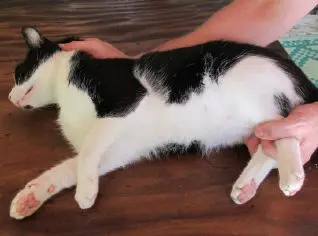For this sheet, I’m going to assume that no veterinary care is available, and no help is coming. While professional help is available, please use it. Each situation is different; this is just a basic guideline to know where to start.
Safe Handling
Make sure you can safely control the animal before you begin. Bite and scratch wounds are very contaminated and turn into infections very easily.
Dogs: control the head. Biting is their primary defense mechanism and even the most tame of dogs may bite if in pain or startled. If you know your dog needs a muzzle and you have one, use it. Usually it takes 2 people, one to restrain and one to examine or administer aid.
- How to restrain a dog: Stand beside the dog, facing it. Wrap arm closest to the head around the neck, with the hand near the ears or upper neck. Wrap the other arm around the abdomen, from above, and hold dog against you as tight as needed.
- How to make a rope muzzle: If you need a muzzle and don’t have one, this works. We would use gauze for this in office, but any form of medium weight cording should work if needed.


Cats and Small Dogs: Sometimes covering the animal with a blanket or towel works also. For dogs: Keep the head under cover, then work on whatever part needs attention. This is usually my preferred method for dealing with cats and dogs that don’t have noses, like pugs. For cats: try to keep most of the cat underneath the blanket and only expose the part that needs attention.
Cats: You may be able to do a “cat stretch” sometimes. Cats are unique in that if the cat freaks out, it turns into a ball of flying nails and teeth. In a home situation, I’d just drop it, walk away, and come back later if this happens. Then try catching it by throwing a blanket over the cat and getting ahold of it through the blanket. Cat stretch hold is: holding the cat by the scruff in one hand holding the back feet in the other and literally stretching the cat out along the table.

Wound Care Tips
Cleaning: Sterile water or saline is ideal, but clean is adequate in a survival situation. If you can, flush the area with clean water or saline (1 tsp salt per quart of water), more flushing is usually better. Try to get dirt, matted hair out if you can. Dab with clean gauze or cloth if needed, try not to rub or cause more tissue trauma.
Stitches: I’m not going to address stitches. If you have the resources, then by all means go ahead. I’m going to assume here that we will be handling it as an open wound and allowing the wound to fill in with scar tissue. If the area is not very large or deep, the best course may be to apply a topical antibiotic and leave it un-bandaged. If however, it is extensive or pretty ugly, it should probably be covered. Plan on re-bandaging every day. A moist open wound will turn into a really nasty infection quickly if kept damp, covered and left alone.
Bandage management: remove the wrap or bandage everyday, check the area, clean it if it looks weepy, re-apply antibiotic ointment and rewrap. Go as long as necessary. This may take a lot of bandaging material, so use resources wisely.
General tips:
- Manage wounds without a bandage when you can, wounds exposed to the air, tend to dry and not go to infection as easily.
- Scar tissue will shrink over time. This is usually good, but can cause problems depending on where it is on the body; however, there is very little that can be done about it.
- Any deep penetration into body cavities is not likely to have a good outcome.
- You can gauge how an animal feels by responsiveness, appetite, restlessness. Try to keep the animal from licking the wound. E-collars work well; if you have one, use it. If not, use your ingenuity to make one: cardboard, rolled up towel with electrical tape to make a stiff neck collar, pool-noodle over the collar… anything that safely prevents them from reaching the site.
- See “Stitches” above under “Wound Care Tips” for how tight to make a bandage – same applies.
Broken Bones
Try to feel where it’s at, carefully. Limb below the break is usually non-weight bearing, tends to be held up and hang loosely. At the fracture site is usually a crunching/grinding sensation. Assess whether the skin is broken.
Splinting: to immobilize a bone, the joint above and below the break, needs stabilized.
-
Try to wrap a layer of padding/cotton/loose gauze material under the splint. Place whatever you’ve chosen for a splint, then wrap the whole thing to hold in place on limb.
-
Too loose and it falls off, too tight and the splint can cut off circulation and cause limb damage. So, when you’re done, check the toes: they should not be swollen or painful. There should be sensation in the toes and they should be warm. If you’re not sure, recheck in an hour. Re-do it if you have to.
-
You may not get great alignment. The goal is a functional limb, not a perfect limb. Do the best you can.
-
So, what if the break is shoulder or hip? A front limb can be flexed into a natural position and wrapped to the body. If the break is hip or pelvis, the best bet is usually strict cage rest.
-
Completely support animal with a sling or towel under abdomen to go outside for potty as necessary. Once again this is less than ideal, but will hopefully give the animal a chance to heal.
-
An open skin fracture is much more of a challenge, because there is now contamination and possible infection in the fracture site. Clean the wound, and go on the the splint. Use antibiotics if you can spare them.
-
Complete healthy bone healing is usually 6-8 weeks.
Vomiting and Diarrhea
Probably the most common complaint for dogs and cats.
Standard directions for repeated vomiting/diarrhea beyond what’s normal for that pet:
-
Take away food and water for 6 hours or so.
-
Offer water first, if that stays down move onto food a few hours later.
-
Offer a few kibbles of normal food, if that stays down then feed the next meal lightly. Followed by normal amount on the next meal.
-
If the animal won’t eat its normal diet, you can offer bland options in small proportion: such as boiled chicken, cooked rice, cottage cheese.
-
Obviously avoid known food allergies.
-
The goal is slow reintroduction of food. We may have to be creative in survival situations.
Notes on food behavior:
-
Cats are strict carnivores. They require meat for functional health. In a time where pet food is scarce and the cat is willing, allow them to hunt for some of their own dinner. Or try to allow them some scrap pieces of meat/egg. Note that hunting could result in the animal getting parasites: Use dewormers periodically if you can, and use good personal hygiene when handling the pet and especially pet wast
-
Dogs are not strict carnivores. They are much more dietarily flexible; will eat some grains, vegetables, and will scavenge. However, vomiting is also a natural part of that cycle, so as house pets, I’d restrict the scavenging. In a no pet food situation, a dog should be able to live off of your dinner scraps. (Avoid onions, raisins/grapes, chocolate and any known food allergens as you can.) Having said that, be prepared for some vomiting, depending on the pet. You will likely encounter something that doesn’t agree.
-
Stock up on pet food as you have room. I’d use a dry food, just because it’s much more calorie dense. Wet foods are 70% water. Packaged dry food should last well beyond expiration date.
Ear Infection in Dogs
This is a very common problem for some dogs.
This will present with shaking the head and scratching at ears. When you pick up the ear and look inside, the canal(s) area is typically very red and frequently has dark brown discharge. It has a uniquely nasty odor of sweet/fishy. Once you have smelled this you will recognize it again. The way most common cause is a yeast organism, called malasezzia. When a yellow foul discharge is present, it’s more likely bacterial.
-
If you own one of these dogs, continue with the meds you have. You know what I mean.
-
If this is a new problem or you run out of meds: You can make an ear wash in the ratio of 2/3 clean water and 1/3 vinegar (white or apple cider) Put a little wash, like several drops in the ear, massage ear, then wipe out the ear with cotton balls/Kleenexes/clean towel/rag. Do this once or twice a day for about 7 days. If the ear gets redder or symptoms worse, then stop the washes. Yeast infections, characteristically like an alkaline environment, so acidic solutions can help clear or control them.
Poisoning
Primarily a dog problem as they tend to be more indiscriminate eaters, so this section is directed at dogs.
Try and figure out what they ate, how much and when. Most things are dose dependent: a Chihuahua that eats 8oz of baking chocolate may actually die and Rottweiler may not even be affected.
If the dog ate the toxin in the last 60-90 minutes, you can try to induce vomiting:
-
Hydrogen peroxide: dose 1-2ml/kg = 0.4-0.8 ml/lb. = 1/12 -1/8 tsp/lb. Given by mouth. If nothing happens, you can repeat in 20 minutes (if it’s in the time frame.) Only 1 repeat and it usually works in the first 10 minutes, if it’s going to.
-
Caveats: Do not induce vomiting if the substance is a corrosive acid or alkali : like battery acid or lye: it just burns everything on the way down and back up. I have never seen a dog stupid enough to eat anything like this, but you never know.
-
If the dog ate a corrosive substance or it’s past the time frame for inducing vomiting, or at least 30 minutes after the dog vomited the toxin up.
– Use activated charcoal powder to try to adsorb remaining toxin. 1 cup of activated charcoal is about 75g.
– Dose: 1-4 g/kg = 0.4 g -1.8 g/lb = ¼ -2/3 cup/ 25 lbs. body weight. You will need to mix this with something to give it. We would mix it with canned food and see if the dog would eat it. You can mix it with water and syringe feed it.
Over the Counter Drugs
Calculation notes: drugs are usually dosed in mg of drug/ kg of body weight. There are 2.2 lbs. per 1 kg. There are 5ml in 1 teaspoon. In previous sections I’ve tried to give conversions for you, since we, Americans still use imperial measurements and it’s hard to tell what measuring tools you might have on hand.
Mini drug dosing medical dictionary:
-
BID – twice a day
-
SID – once a day
-
TID – three times a day
-
QID – 4 times a day
-
PRN – “pro re neta” – as needed
-
PO – “per os” – by mouth
-
IM – intramuscular injection
-
SQ – subcutaneous injection
-
IV – intravenous injection
Example dose calculation:
- 50 lb. dog needs Benadryl at a dose of 2mg/kg PO BID
- 50#/2.2Kg =22.72 kg weight | 2mg dose x 22.72kg =45.44 mg
- The dose is 45.44 mg given by mouth twice a day. Benadryl doesn’t come in 45 mg so the closest dosing would be 2 of the 25 mg or 50 mg.
Do not give animals Tylenol. One Tylenol kills an average 10# cat. Dogs may survive, but there can be serious liver damage. Don’t do it. This is one drug I use cautiously even with the people in our family. It has it’s uses, but do not overdose this. Side note: NAC is used for Tylenol overdose in people, I don’t know the regimen. Check a human resource if you want to know.
Basic formulary of common drugs for dogs:
- Aspirin: Dogs for pain/arthritis – 10 – 20 mg/kg by mouth 2 to 3 times a day. Aspirin is a non-steroidal anti-inflammatory. It can cause stomach upsest and ulcers and can act as a blood thinner (anticoagulant.) Try to give with food or use a buffered form. It usually comes in 65mg, 81mg and 325mg.
- Benadryl (Diphenylhydramine)– for allergic reactions like hives, red and irritated skin, itchiness – 2mg/kg by mouth 2 or 3 times a day. This is an antihistamine. It can cause drowsiness. I usually top out at 75 mg even if the calculated dose for a large dog is more, because it just seems to really knock them out. In an emergency I would use it as a sedative if you have need and can safely administer it. It usually comes in 25mg capsules or tablets or a liquid 12.5 mg/ml syrup.
- Ivermectin: for parasites and mange – 0.2mg/kg (1ml/110lbs.) by mouth. Repeat in 2 weeks. There are many products on the market. I use the 1% bovine injectable product and as an oral medication. This is an older way of using it. Collies seem to be sensitive to Ivermectin, so generally don’t use it with that breed. Side effects at high doses are usually neurologic: tremors, disoriented, weak, agitated. If you see any side effects just stop using it. Symptoms will go away.
- Maalox (Aluminum hydroxide and magnesium hydroxide) – for upset stomach or stomach ulcers – 2-10 ml by mouth every 2- 4 hours. I would probably not repeat more than 3 times. If it hasn’t worked by then it’s not likely to. It is an antacid. Do not use if the dog has ingested bone. The antacid will prevent the stomach acid needed to break down and pass the bits of bone.
- Pepto-Bismol (Bismuth Subsalicylate) – for diarrhea – 10-30 ml every 4- 6 hours. Do not use with aspirin as this product already contains a form of aspirin.
- I did not list any drugs for cats. They are hard to medicate and they don’t metabolize many drugs as well as dogs. The canine dose of ivermectin is safe for cats as well. If you give it, some cats will foam at the mouth after oral medications; the cat is fine. Let it chill out somewhere safe and don’t repeat unless you have to.
- There are lots of more effective medications that your veterinarian can provide and administer, so please use them while we still can. The list is just for a few safe things that you may have in your cabinet to use if no real help is available.
References: Kirk and Bistner’s Handbook of Veterinary Procedures and Emergency Treatment, 7th Edition by Stephen Bistner, Richard Ford and Mark Raffe & Veterinary Drug Handbook, 2nd edition by Donald C. Plumb.

























0 Comments